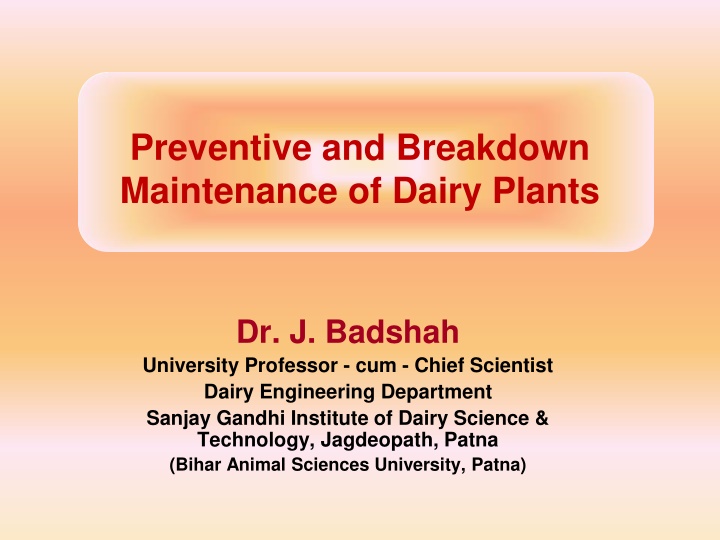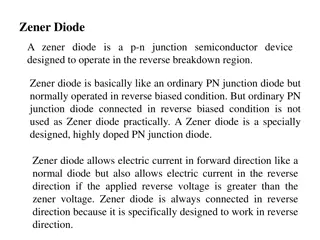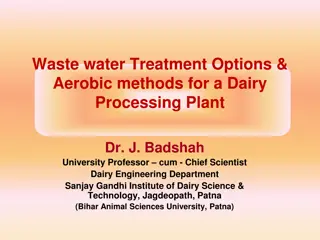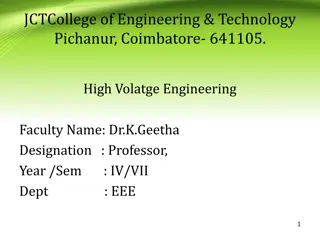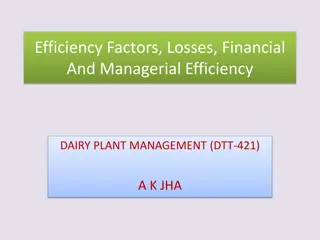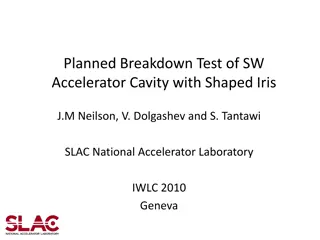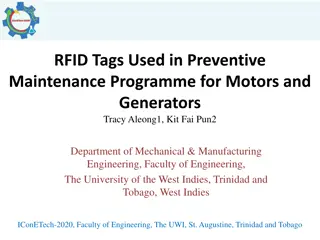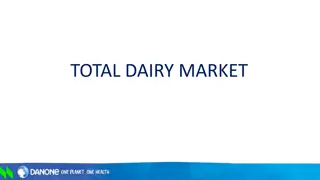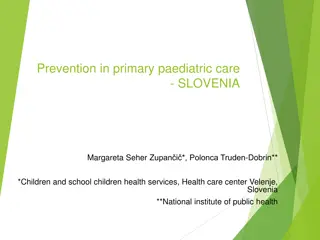Dairy Plant Maintenance: Strategies for Preventive and Breakdown Care
Preventive and breakdown maintenance of dairy plants is essential to ensure continuous production and quality control. Dr. J. Badshah, a renowned expert in dairy engineering, explains the importance of corrective and preventive actions, scheduling maintenance tasks, identifying root causes of defects, and optimizing plant performance through strategic planning. Learn how to maintain optimal operational parameters, handle breakdown situations effectively, and enhance overall efficiency in dairy plant operations.
Download Presentation

Please find below an Image/Link to download the presentation.
The content on the website is provided AS IS for your information and personal use only. It may not be sold, licensed, or shared on other websites without obtaining consent from the author.If you encounter any issues during the download, it is possible that the publisher has removed the file from their server.
You are allowed to download the files provided on this website for personal or commercial use, subject to the condition that they are used lawfully. All files are the property of their respective owners.
The content on the website is provided AS IS for your information and personal use only. It may not be sold, licensed, or shared on other websites without obtaining consent from the author.
E N D
Presentation Transcript
Preventive and Breakdown Maintenance of Dairy Plants Dr. J. Badshah University Professor - cum - Chief Scientist Dairy Engineering Department Sanjay Gandhi Institute of Dairy Science & Technology, Jagdeopath, Patna (Bihar Animal Sciences University, Patna)
Corrective and Preventive Action Corrective and Preventive actions are process of actions to be taken in equipments and machineries to avoid the undesirable conditions of sudden stoppage of production or service activities of plants. Its proper management is necessary to control the quality, safety and costs. Actions required to correct the root cause of defects to avoid the recurrence are known as corrective actions. It actually occurs after the defects and breakdown have occurred in the plants and purpose of corrective action is to avoid the recurrence of the problems and to bring-up the plants in working condition again. Due to this, it is also known as Break down maintenance. It is necessary to identify the root causes. Preventive actions/maintenances are the actions taken before occurrence to avoid the failures due to potential causes. It is done before occurrence and it is scheduled for identification and actions on potential risks. Potential risks may be out of any input resources such as man, machine, measurement and mother nature (i.e. 6Ms) materials, methods,
When to carry out Breakdown maintenance and Preventive maintenance Un-acceptable level quality, safety and non-conformance of standards of products and consumer rejection report: the root causes are identified and the equipment is dismantled and proper repairs, replacement and maintenance actions are taken. Issues identified in internal audits such as process audits, machine audits, layout audits etc. the root causes are identified for corrective actions. Adverse or unstable trends in production or service rendered by machines / equipments are reported in Statistical Quality Control (SQC) Processes. It results in rejection of products or services and root causes are identified to take corrective actions. It would avoid the recurrence of defects and controls the system and reduces the loss of time and costs. To prevent the failures to come, potential sources of non- conformity are identified and maintenance are planned as a schedule through-out the year is preventive maintenance i. ii. iii. iv.
Planning of Plant Maintenance Administrative Information: Purchase details, testing and commissioning services details, warranty & guarantee details of plant and machineries Technical and Specific details of Equipments and Machineries: operational parameters, lubricants and utilities required Inventory level requirement in stores specific to separate equipments/machines Study of the performance of equipments and machines Identifications of critical points Check - up of different units and follow up the Preventive maintenance schedules Frequency of check ups of the output products and services Arrangement of electrical and mechanical workshops with maintenance teams to handle the situations of Breakdown maintenance, if any and also the Preventive maintenance as per the schedule. Maintenance of power sources, distribution system, load scheduling for 24 hour period is planned to control load factor, power factor, efficiency of large motors, automations of machines. Measurement of operational parameters in log book of each small and big equipments and machines is necessary for recording so that the problems can be identified and losses can be minimized. Check the maintenance program includes the recommendations of Plant and energy audit teams.
Principles of Preventive Maintenance Routine External Check-ups: Vibration, Sound, heating Periodic Internal Check-ups: Lubrication, minor adjustments, surface touch ups etc. after the equipment is shut down Major Repairs/ Overhauling of machines: Prior to shut down, procurement of spares must be ensured, shut down available in lean seasons Evaluating the Performance Frequency of evaluation through measurement and calibration of parameters is a matter of experience and performance evaluation is done based on log book entries. Periodic Check ups of distribution lines of all utilities: leakages Record Keeping and reporting by the operators: Records of operating parameters, malfunctioning and complaint records, lubrication records etc. To compare from Bench mark values/ Rated values of parameters. of equipments/machines:
P.M. of Steam Boilers Check the boiler blow down process. Check the working of water level gauge glass indicator system. Check the report of softener water and ensure that hardness not to exceed 10ppm. Check the belt conveyor gear box oil level. Check the coal bucket gear box oil level. Steps to Improve Performance Use variable speed drives on large boiler combustion air fans Inspect oil heaters for proper oil temperatures Clean burner, nozzles, strainers etc. Establish a boiler efficiency maintenance Program Follow the steps involved in preparation of boilers for statutory inspection Start with energy audit and follow up program for energy conservation as well as improvement of boiler efficiency Add an economizer for heating feed water and air preheater using waste heat of combustion flue gases
P.M. of Refrigeration machines Check the insulation of chilled water lines, cold storage and IBT Timely and periodic air and oil purging from the system It is advisable to segregate IBT, cold storage and Deep Freeze suction lines and connecting to separate refrigeration compressors The refrigeration effect must be efficiently utilized by elimination of losses of chilled water and heat losses Efficient running of refrigeration maintenance of compressors Periodic cleaning of evaporators and condensors (0.8 mm scale built up on condenser tubes can increase energy consumption by 30-35%) Night time running of compressors reduces the peak load and minimum KVA consumption and reduced electric bill Timely preventive maintenance of compressors and systems Minimizing reprocessing load to zero level. Efficient running of cold storage, deep freeze and Ice-cream sections compressors and Preventive
P.M. of Air Compressors and Submersible Pump for water Adequate intake of filtered and cooled air. Avoid leakages and maintain minimum pressure drops in air lines Proper removal moisture from compressed air distribution system Segregation of low and high pressure air requirements and Proper and effective maintenance of compressed air generation and distribution system The primary maintenance items of inlet filter, oil drain, oil fill, motor greasing, condensate traps, and control calibration. Each should be easily accessible. Service indicators help guarantee timely maintenance. Synthetic lubricants must be replenished regularly provide superior lubricating characteristics, longer service life, and lower vaporization rates. Poly-glycols extend change-out intervals to 8,000 hours, have the lowest biodegradable. Oil-free compressors require limited amounts of lubricant for bearings and gears vaporization rate, and are
P. M. of Electrical Machines & Appliances Maximum demand of electricity should be monitored properly to reduce the electric bill Power factor should be controlled to near unity Use energy efficient motors, equipments, transformers and othe appliances Use of soft starters for heavy duty motors to improve power factor Use of CFL/LED lighting devices Multistage compression in case of high pressure ratio, Selection of refrigerants Eco-friendly hydroflurocarbon (HFCs) are replacing fully halogenated (CFCs) Refrigerants. Install variable frequency drive and monitor system performance. Hydrocarbons and
P.M. of Milk Processing and Manufacturing units in a Dairy Plants Centrifugal Pump Maintenance: Locate the pump at a level below the liquid source for positive suction head. All piping and particulary suction line should have minimum length and minimum elbos and bends. Don t throttle the suction line to control the capacity. Don t start the pump with discharge full open, also in dry condition and without checking direction of rotation i.e. from motor side, the rotation should br clockwise. Mechanical seal and Pump casing O ring should be equal to at least nos. of pumps. If the pump does not generate the required discharge head rapidly, stop and repeat the priming operations. HTST Milk pasteurizers: Periodic cleaning and maintenance of milk pasteurizers. Chilled milk pipe lines and holding section pipe line should be properly insulated. Milk pasteurizer temperature must be controlled properly with PID controller and FDV system to produce safe pasteurized milk and to avoid reprocessing. Plant regeneration efficiency should be monitored and controlled properly. Old milk pasteurization plant with poor regeneration efficiency, pinholes in plates and poor hygiene should be considered for replacement.
Piping installations supported independently avoiding stresses on the pumps. Pipes must be causing Internal diameter must be of the same size as that of pump connection. If the pipe diameter changes along the suction line use reduction cones in such a way that slope is towards down stream and no air pocket is formed. The suction pipe must be as short as possible. The maximum velocity in suction pipe should not be greater than 3 m/s (Most recommended is 2-3 m/s). The suction pipe must be designed in such a way to prevent air from entering the pump. Fit expansion joint in case of hot liquid transportation in pipes to compensate any expansion of the pipe.
P.M. of Manufacturing Units..contd. Ghee is made in dairy plant from butter or directly from cream. Clarification of butter in ghee kettle requires high amount of steam because butter contains 16 % moisture. Instead of this procedure a large portion of water can be removed by centrifuging the melted butter and then clarifying in the ghee kettle. It can save steam and time and also would improve the capacity of plant. The heat of already clarified ghee can be used to melt the butter. Use of Scraped surface heat exchanger system for forewarming and concentration of milk to prepare small scale and economized condensed milk and indigenous dairy products for energy saving and quality production. Use of Non- thermal technologies such as Membrane technologies in milk processing, High Hydrostatic pressure technology for cold processing, Superfluid extraction packages for dairy products, pulsed electric field technology, Nano technology for nano food and intelligent packaging etc. are the scope for producing qualitative and functional safe foods by optimizing energy consumption (Minz, et. al, 2010). technology, Eco friendly
P.M. of Condensing and Drying Plants 5-effects evaporator with TVR: 8 kg water evapn per kg steam 7 effects evaporator with TVR: 10 kg water evapn. Per kg steam Multiple effects evaporator without condenser with MVR: Low steam consumption in comparison to equivalent evaporator with TVR and no cooling water requirement. Use of multipass construction in each effect to retain the advantages of tube wetting rate for different products to make flexible. Higher degree of automation gives higher quality with lower cost. Full automation of spray dryers and feed treatment to control moisture content in the powder and also to control quality of powder including avoiding burnt particle and safety of drying chamber must be provided in the system. This may be done by feed rate regulation through servomotor and positive pumps or by air heater regulation. Three stage dryer efficiency increases by 20 percent from 35 % to 55%. To reduce stack losses, bag filter, cyclone separator and wet scrubbers etc. should be efficiently designed and installed. Their efficiency should be checked regularly.
P.M. of solar energy modules installed in plants Solar energy can be used for hot water generation for milk pasteurization and CIP To install fully self tracking parabolic solar concentrator for generation of hot water and storage in a tank to save furnace oil used for boiler Biofuels offer a sustainable and cleaner source of power, with significantly lower green house gas emissions. Biomass (wood waste/agricultural residues etc.) gasifier has high potential for production of low calorific value gas for small scale agro based industries for thermal energy and electricity applications. Solar electric also known as photo voltaic cells that convert sunlight directly into electricity for lighting, battery charging, small motors, water pumping and electric fences etc.
P.M. of Effluent Treatment Plants There is considerable scope of energy conservation, if effluent generation and treatment are given due attention Segregate low BOD and High BOD streams to save energy and land for aeration lagoons in aerobic digestion The combination of anaerobic cum aerobic treatment plants offers huge savings For water recycling and reuse, the concept of tertiary treatment to give good quality water should be adopted Use of Upflow Anaerobic Sludge Blanket (UASB) technology followed by Aerobic treatment saves not only energy consumption and energy cost but also produce bio gas. Methane/bio gas can be used to generate electricity which further reduces the operating and thereby production cost of product. Biomethanation of dairy effluent is an anaerobic treatment process of dairy effluent to remove the organic substances and to convert them into methane rich biogas. The methane content in the biogas is 65%. The reactor can tolerate an organic loading of 10 kg COD/ cubic meter reactor volume / day. Methane rich gas is produced through this process and can be utilized for thermal applications and power generation as well (Rathore, 2010).
Maintenance of Milk Pouch Filling Machine Dismantle both fixed and mounting horizontal jaws for cleaning the electrodes. The use of a hand brush with trichloroethane is recommended. It is to be remembered that rubber linings are to be changed for every 40,000 pouches. Check the condition of Teflon, rubber lining and sealing wire. When changing the adhesive Teflon, do not forget to disconnect the sealing wire to remove any cooked milk that could be found. Change the oil/grease in the gearbox after every 2,000 hr of operation Low air pressure (6 kg/cm2), Worn out O rings in horizontal seal cylinder , Jaw pressures adjusted too low and will cause horizontal seal leaks. Corner seepers are very small leaks at very corner of the horizontal seal. Which is due to compression of the pouch in the crates. Proper maintenance of horizontal sealing and back-up bars is to be followed.
Vertical seal leaks in Pouches Weak Seals are caused due to lack of heat , which may be due to: Too low a setting on the vertical seal adjustment Poor sealing relay contacts Poor electrical connections Poor contact on rheostat controls Increase in flow rate of cooling water Pin hole and Burn holes caused Due to too much heat or little pressure on the vertical seal. vertical seals overlap. Burn holes appear only when
